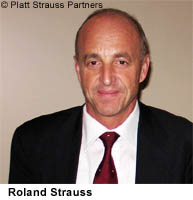Starting an innovative dialogue
Innovation has been the buzzword in European corridors for some time - innovation is, we are told, the way to pull up the EU economy by its bootstraps and secure our long-term prosperity. However, as the endless reports and conferences show, people are very keen to talk about innovation, but how do you go about actually innovating? Dr Roland Strauss had an idea - you must make innovative companies talk to one another and use the pool of knowledge for everyone's benefit. 'I used to have clients in innovative sectors, and they wanted to try and find organisations with similar interests from other EU countries,' Dr Strauss said in an interview with CORDIS News. 'So we gathered together the major stakeholders that made up this innovation ecosystem,' he said. This laid the foundations for a way to nurture innovation within Europe - through dialogue - with innovative companies at different levels talking to one another. Dr Strauss fist presented his ideas to the European business community at the launch of his company's European Innovation Dialogue (EID) launch in Brussels in December 2005, and then again in a presentation to the European Parliament in January. This was shortly before the publication of the influential expert group report on innovation, chaired by former Finnish Prime Minister Esko Aho - a blueprint for prosperity through innovation. But Dr Strauss' reasons for pursuing innovation came from somewhere simpler - looking to the prospects for future generations. 'Really, I think of my kids,' he said. 'I was the German EU ambassador for standards, so I have a view of global competitiveness. The hook is to look to the future with a global view. The EU's competitiveness, growth and jobs are dependent on capitalising on innovation, to keep living standards high. This is crucial for the EU's economic return,' he said. Dr Strauss, partner in Brussels-based Platte Strauss Partners developed the idea for EID, to encourage innovation by encouraging communication between innovative partners. The ecosystem idea is central to EID. Successful innovation will take place in a healthy innovation ecosystem. So, if key players are missing, innovation will not flourish. 'If the ecosystem is not complete, then the innovation will not happen,' he said simply. Dr Strauss wants EID be the lubricant that can plug the gaps, and so develop an environment geared towards innovation, and the main way to do this is to get people talking. 'The main dimension of EID is to bridge the gap between high-level policy at the EU, national level or Lisbon strategy level, and the local practitioner, who has day-to-day concerns about how to be a successful innovator. There are links between these two, but we want to narrow this gap,' he said. Dialogue can happen at other levels, too, says Dr Strauss. For example, individual cities can be key drivers of innovation, and the Finnish city of Oulu is a sponsor of the next EID event, the first in a series of regional events focusing on innovation. Oulu has a strong track record in developing the 'innovation ecosystem', and is there to share some of its wisdom. The first regional event will take place in Budapest from 21 to 23 June, with strong support from the Hungarian government. 'We wanted to bring together innovative actors to discuss how innovation could foster economic growth in Hungary,' Dr Strauss said. He hopes this will be done practically, with four 'panel' events. The first will examine the right policy for innovation to flourish in Hungary. The second panel will look at how innovation can be successfully funded. Third, a Best Practice panel where experts, such as those from Oulu or from innovative enterprises, share their experiences, and finally the Action Plan round table, which hopes to tie together the knowledge from the first three panels, and develop a recipe for Hungarian innovation. One problem Dr Strauss encountered early on was how to involve small and medium-sized enterprises (SMEs) who do not typically have the funds for such large conferences. 'SMEs are difficult to attract due to lack of resources,' he said. This is a significant barrier, as innovative companies are typically SMEs, and SMEs account for close to 60 per cent of EU GDP. 'We try to attract SMEs instead at the pre-conference stage. These will then feed into the information sessions. We will be able to offer one-to-one meetings, scheduled from the conference website. This again gives SMEs the chance to discuss issues such as the Framework Programme, intellectual property, technology transfer, EU grants and so on with people from national and regional government,' he said. This will also give SMEs the chance to open dialogues with larger businesses. Once again, it is all about communicating and opening lines of access. Dr Strauss is confident that after some talking, larger businesses will find they have room for some of the smaller players as part of their innovation strategy. Government representatives will be in attendance to answer questions from the assembled delegates, such as what can be done to help business. This, in essence, is the key to the way Dr Strauss wants to see his children - in an environment that encourages innovation. 'We take everything down to the ground level, something the Commission cannot do,' he said.
Countries
Hungary

